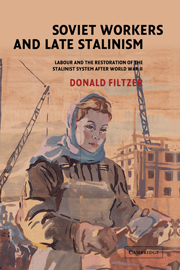 Soviet Workers and Late Stalinism
Soviet Workers and Late Stalinism Book contents
- Frontmatter
- Contents
- List of tables
- Preface and acknowledgements
- List of terms and abbreviations
- Introduction: the political imperatives of the postwar recovery
- 1 Rebuilding the workforce: free, slave, and indentured labour
- 2 The food crisis of 1946–1947
- 3 Attenuated recovery: the end of rationing, housing, and health
- 4 ‘Socializing’ the next generation: the position of young workers
- 5 Labour discipline and criminal law: the futility of repression
- 6 The industrial enterprise: working conditions, work organization, and wage determination
- Conclusion: labour and the ‘renormalization’ of Stalinist social relations
- Bibliography
- Index
2 - The food crisis of 1946–1947
Published online by Cambridge University Press: 07 August 2009
- Frontmatter
- Contents
- List of tables
- Preface and acknowledgements
- List of terms and abbreviations
- Introduction: the political imperatives of the postwar recovery
- 1 Rebuilding the workforce: free, slave, and indentured labour
- 2 The food crisis of 1946–1947
- 3 Attenuated recovery: the end of rationing, housing, and health
- 4 ‘Socializing’ the next generation: the position of young workers
- 5 Labour discipline and criminal law: the futility of repression
- 6 The industrial enterprise: working conditions, work organization, and wage determination
- Conclusion: labour and the ‘renormalization’ of Stalinist social relations
- Bibliography
- Index
Summary
In this and the following chapter I take a detailed look at living conditions from 1946 through to the early 1950s. I begin by looking briefly at some of the problems of interpreting the data on the USSR's postwar recovery, and then discuss the food crisis of 1946–7, the regime's response to that crisis, and its impact on the non-agricultural population. In chapter 3 I continue the story by examining the modest recovery which began after the end of rationing and the reform of the currency. I also look at the state of housing and health care, which after food had the greatest impact on the quality of life.
Postwar recovery and consumption: analytical problems
When the Soviet Union went to war with Nazi Germany it was already an extremely poor country. Industrial production had grown immeasurably during Stalinist industrialization, but this had not translated itself into a higher standard of living for the population. On the contrary, the standard of living fell during the 1930s for both rural and urban residents. It is therefore not difficult to imagine how much worse – catastrophically worse – the situation was when the war ended in 1945. Mark Harrison has recently argued that during the war available resources had been so badly constrained that the country had been unable to sustain its entire civilian population.
- Type
- Chapter
- Information
- Soviet Workers and Late StalinismLabour and the Restoration of the Stalinist System after World War II, pp. 41 - 76Publisher: Cambridge University PressPrint publication year: 2002


